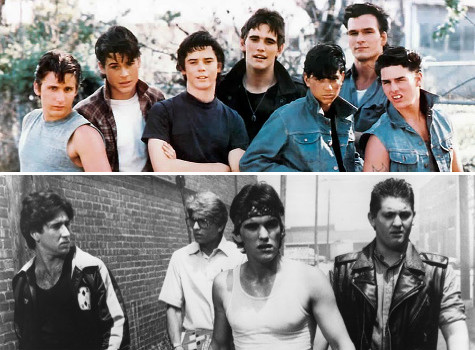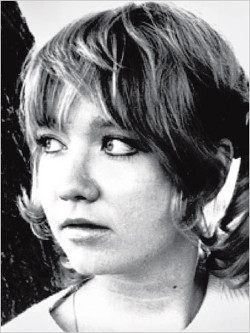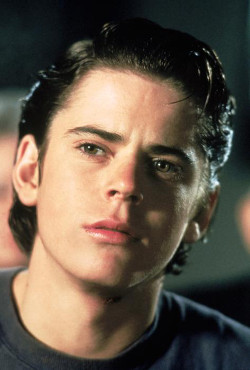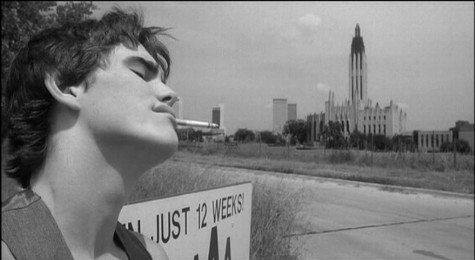
There are those who see Francis Ford Coppola’s cinematic output as being divided into two distinct halves. According to this theory, there’s one set of his films that are of a classic Hollywood style and comparatively mainstream; then there’s another more personal and artistically pure group of releases. Whether or not you think this is a valid means of assessing Coppola’s work in films, there can be little question that his two 1983 movies based on the young adult novels of S. E. Hinton illustrate each of these approaches.
The Outsiders is a movie whose story just about anybody can grab onto, with its easily graspable dramatic episodes. Rumble Fish, by contrast, is a more deeply layered tale and more of an esoteric product, as well as a more experimentally shot film. Criterion Collection’s new edition of Rumble Fish provides an opportunity to give a fresh exploration of it, The Outsiders, and the two Hinton books they’re based on.

Before we move into a closer look at the two films, it’s worth taking time for a short discussion on the author of the novels upon which they’re based. S. E. Hinton is a woman, as most who know her work realize by now. But when The Outsiders (1967)—which she wrote while in high school, and which was published when she was still a teenager—was released, her publisher thought it best that she disguise her gender, thus the initials in place of her first name, Susan. She has kept this author name throughout her career. It seems her publisher, Viking Press, thought that a novel about teenage street gangs wouldn’t feel right to some readers if they knew it was written by a woman. Bah.
The Outsiders is, of course, a classic work and one of the great young adult novels in existence. You can see it as teenage noir, if you want to classify it in that way. Hinton’s Rumble Fish, her 3rd book, was published eight years after her debut. There are parallels between the two novels, which share similar content and characters, yet they are markedly different from each other—as are the movies made from them. The Outsiders has more action and more straight-from-the-heart drama, while Rumble Fish is a quieter, moodier, more abstract work of teen lit. Hinton co-wrote the screenplay for Rumble Fish with Coppola, and she has a bit role in that film.
Now we can look at both stories and compare both the literary and cinematic versions. When it comes to plot, Coppola’s movies are nearly identical to Hinton’s books. Also, there are similarities in the ways both the author and the filmmaker presented each of the stories. What both tales have in common is they are based in Oklahoma and concern hardened teenagers who have to make do for themselves on the mean streets of their towns without much adult guidance or protection.

The Outsiders’ main character, and the narrator of Hinton’s novel, is Ponyboy Curtis, an adolescent “greaser” who is being raised by his older brother, who is just past teenage-hood himself. Ponyboy is a reading fanatic and a dreamer, but his brothers’ and their gang-mates’ battles with the high society “soc” kids who have it in for them keeps his head out of the books and his reveries. Themes that enter into this story—which constantly pulls at your heart—include: the difficulties of friendship and romantic feelings between kids who come from different social classes, the quandary of whether to stick by your friends when it means endangering your life, the difficulties involved with kids having to make life-changing decisions without the counsel of parents or other helpful adults, etc.
Rumble Fish, the book, is also narrated by a teenage boy. This time, it’s a kid named Rusty-James. Rusty-James has a living father, unlike Ponyboy Curtis, but his dad’s a lush and not much of a parent. The mother of Rusty-James and his older brother, who everybody calls The Motorcycle Boy, is long gone from the family. Rusty-James is a tuff kid from a poor family, like most of the characters from The Outsiders, and gang fights are also a major part of Rumble Fish. But Rumble Fish, a more meditative book and film than The Outsiders, is largely an existential examination of Rusty-James’s heart and soul.

It’s also a probing of the mysterious inner workings of the enigmatic Motorcycle Boy and the brothers’ relations to each other. The Motorcycle Boy is a mythical figure, a kind of teenage god, a slumming angel who stands apart from the other kids in the hood and from reality on the whole. He’s smarter and more world-wise than Rusty-James, who has a fair amount of street wisdom but lacks the depth of understanding that his brother possesses. Rusty-James wants to be like The Motorcycle Boy, but can he ever get there? And should he really want to?
Coppola—who had a keen handle on the two Hinton books and seemed to have worked closely with the author when making Rumble Fish—filmed the two sagas in contrasting ways that perfectly captures the aspects that set the two novels apart. He shot The Outsiders in color and Rumble Fish in black and white (apart from some superimposed color images, done that way for artistic effect). The Outsiders movie is filled with melodrama, which sometimes gets maudlin but at other times is genuinely heart wrenching. The film Rumble Fish differs from the The Outsiders because it’s quirkier, stranger, and artier. It plays with your head as much it tugs at your emotions. It’s surreal at times, like the pivotal scene during which Rusty-James has an out-of-body experience after getting nearly beaten to death in a mugging.
There are artful shots in The Outsiders and emotionally stirring moments in Rumble Fish, but overall, the former is primarily made of melodrama and the latter is more of an art film. You could make the case that The Outsiders, while effective in its way as a movie, is one that feels like it could have been made by just about any director. Rumble Fish, meanwhile, is the more unique work.
Coppola used some of the same actors in both films. Matt Dillon expertly portrays Rusty-James in Rumble Fish. And, even though you have to call Ponyboy Curtis the protagonist of The Outsiders, Dillon’s character, Dally, is the one around whom some of the most dramatic parts revolve. Diane Lane also shines in both films, particularly as The Outsiders’ Cherry Valance, an attractive and thoughtful teenage girl who gets torn between the two rival gangs. Well-known actors such as Mickey Rourke, Dennis Hopper, Patrick Swayze, Vincent Spano, Nicolas Cage, Chris Penn, Laurence Fishburne, Ralph Macchio and brat packers Emilio Estevez and Rob Lowe are among those who have roles in one of the two films, and all play their parts well under Coppola’s able direction. Tom Waits and Coppola’s young daughter Sofia, the latter of whom of course later became a film director in her own right, have bit roles in both movies.
Criterion’s new edition of Rumble Fish comes with their usual bounty of bonus features. Among those, the most enjoyable segments are new interviews about the movie with Diane Lane and Matt Dillon, archival footage from the set of the film, and a piece in which a film and literary scholar discusses the philosophical aspects of Rumble Fish.
To learn more or order a copy, visit:
opens in a new window![]() opens in a new window
opens in a new window![]()
Brian Greene writes short stories, personal essays, and reviews and articles of/on books, music, and film. His work has appeared in 25+ publications since 2008. His pieces on crime fiction have also been published by Noir Originals, Crime Time, Paperback Parade, The Life Sentence, Stark House Press, and Mulholland Books. Brian lives in Durham, North Carolina.
His writing blog can be found at: http://briangreenewriter.blogspot.com. Follow Brian on Twitter @greenes_circles

With Rumble Fish I could never get past Matt Dillon’s age. He seemed too old for the book character. I pictured the book characters as 14-15.